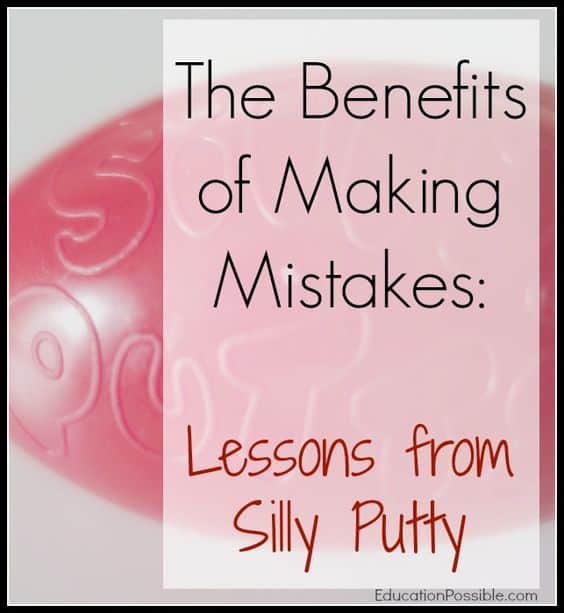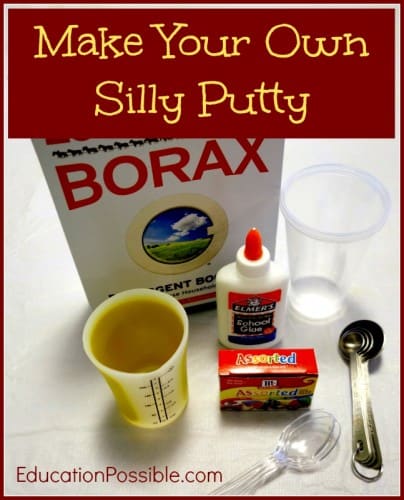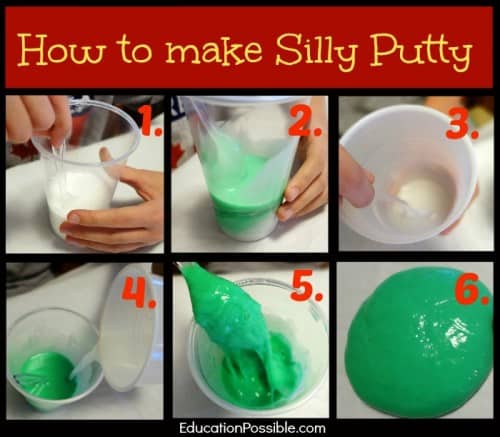The Benefits of Making Mistakes: Lessons from Silly Putty
Add a little “bounce” to your science by adding some silly putty activities to your lesson plans. It’s a great middle school science activity you can do at home.
Have you ever asked yourself the question, what was silly putty originally made for? It wasn’t supposed to be a child’s toy. In fact, when it was created, it was considered useless.
Like the inventor of silly putty, our kids are going to make mistakes and experience failure. One of the best things we can do is encourage our middle school kids to think like an inventor and grow and learn from their mistakes. It’s an amazing life skill for teens that everyone should learn.

The Inventor of Silly Putty
What was silly putty originally made for? Synthetic rubber.
During World War II there was a high demand for products made out of rubber – tires, gas masks, soldiers’ boots, rafts, etc. Unfortunately, the countries which produced rubber could not meet the demand so companies in the United States began experimenting, trying to find a way to create synthetic rubber.
In 1944 James Wright was working on this effort as an engineer at General Electric. Wright was conducting experiments with silicon and one day added silicone oil and boric acid together. The result was an interesting gooey substance. This new substance would bounce, stretch, and withstand high temperatures. But, there was a problem – it would not hold its shape.
Fun Over Function
For several years, Wright sent samples of the goo to scientists around the world. Although they thought it was interesting, scientists and engineers could not find a practical use for it.
In the early 1950’s Peter Hodgson, an advertising consultant had the idea to place this interesting substance in small red plastic egg-shaped containers and market it as a toy. Because the goo could be bounced, shaped, and used in a variety of entertaining ways Hodgson decided to name it “Silly Putty”.
For more than 50 years Silly Putty has been a favorite of adults and children. Over the years it has been called a “Real Solid Liquid” and a “toy with one moving part.”
Although Wright’s goo was not used for its intended purpose, it has been used and enjoyed by people all around the world. It has even been used in a few scientific applications over the years as well. It traveled into space on the Apollo 8 mission and has been used in zoos to take foot impressions of animals.
Silly Putty Activities
Making our own silly putty is one of my kids’ favorite homeschool science activities. We have called it Flubber, Gak and Silly Putty – no matter the name, it is always fun and easy to make.
Supplies
-
- White Glue
- Borax
- Water
- Food Coloring (optional)
- 2 Bowls
- Mixing Spoon
- Measuring Cup
- Tablespoon
- Plastic resealable bag

Instructions:
- Mix ¼ cup of white glue with ¼ cup of water in a bowl. Stir until water and glue are completely combined.
- Add food coloring (if desired) and stir until combined.
- Place 1 tablespoon of Borax in a separate bowl. Add 1/8 cup of water. Stir for 1-2 minutes until borax is dissolved. If some of the Borax is still “grainy” your silly putty won’t be as smooth.
- Add the Borax mixture to the glue mixture and stir. As you stir the substance will begin to congeal. If it’s too wet or sticky, add a little more Borax. Continue to stir until the mixture all sticks together.
- Take the substance out of the bowl and knead it with your hands for about 5 minutes to get a smooth consistency.
- Store in plastic resealable bag, in the refrigerator. When removed from the refrigerator let it warm to room temperature for about 10 minutes.

If you would like to learn about more inventors and their mistakes, let us recommend one of our kids’ current favorite books – Mistakes That Worked: 40 Familiar Inventions and How They Came to Be by Charlotte Foltz Jones.
Learn the stories behind the ice cream cone, popsicles, chocolate chip cookies, the Frisbee Disc, Ivory Soap and more!
More Hands-on Activities for Middle Schoolers
- The Benefits of Making Mistakes: Lessons for Middle Schoolers from the life of Thomas Edison
- The Benefits of Making Mistakes: Middle School Lessons from Toll House Cookies
- A Helpful Biography Report Template for Middle Schoolers
Join us this week as we take a look at some of our favorite inventors, and their inventions, to understand the successes and failures they encountered and the important lessons they learned along the way.
What lessons are your teens learning about famous mistakes?



A fellow blogger wrote about persistence which relates because our learners need to understand that making mistakes is part of learning and if they knew that they would be less likely to give up. Dr. Suess and J.K. Rowling were rejected so many times before they succeeded. Important concept and fun post to illustrate.
I agree Mary, it is also very important to talk with our children about persistence! There really are very few “over night successes” and we should learn more about the stories of the long, challenging roads people have traveled.
What a cool backstory! I never knew that about Silly Putty. This would be really fun to make with the kids. Pinning this an hoping to try it out soon!
Carrie, I hope they have fun with the experiment! I like combining a hands-on activity with a life lesson. It’s fun hearing the kids sharing the back stories to family and friends like they just uncovered a big secret! 🙂
What a fun book!! Thanks for sharing via Family Fun Friday. I am featuring your post this week. 🙂